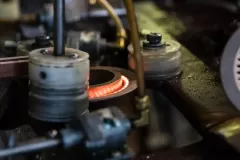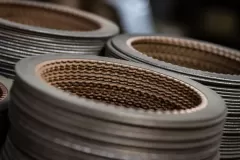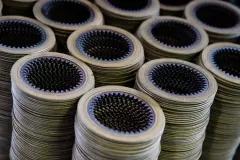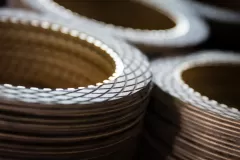Wet Clutch and Wet Disc Brake Applications
GMP Friction: The Leader In Wet Clutch and Wet Disc Brakes
GMP’s materials are well suited not only for dry brakes and clutches but for wet friction applications as well. For instance, under our high-quality process controls, GMP Friction Products’ unique copper powder produces a clutch plate or wet brake disc with an oil-retaining porosity unlike any other. This oil within the friction material is available then, in addition to the oil in the sump and our molded grooving, at the peak moment of engagement to cool the clutch precisely when the energy demand is greatest. The result: stable friction with the highest peak specific power and highest peak specific energy.
It’s no surprise then that GMP’s, sintered bronze and other sintered friction materials are utilized in a wide variety of wet disc brakes, multi-disc brakes, and wet clutches. They are found in such high-energy, high-demanding applications as marine transmissions, mining equipment, and construction equipment.
Call Today: 330.633.1226
ISO 9001:2015 Certified
CAGE CODE: 01141
What is a wet clutch?
A wet clutch is a type of clutch used in some vehicles, particularly motorcycles and high-performance automobiles. It gets its name because it operates in an oil bath, meaning it is immersed in a lubricating fluid, usually oil. The oil serves multiple purposes in a wet clutch system:
- Cooling: The oil helps dissipate heat generated during clutch engagement and disengagement, preventing the clutch from overheating.
- Lubrication: The oil lubricates the moving parts of the clutch, reducing friction and wear.
- Reducing Noise: The oil can help dampen noise generated by the clutch.
In a wet clutch system, the clutch plates are submerged in oil when not engaged. When the clutch is engaged (the plates are pressed together), the oil is squeezed out, allowing the plates to grip each other and transmit power. This design is often chosen for high-performance applications because it provides better cooling and can handle more intense use compared to dry clutches.
In contrast, a dry clutch operates without being immersed in oil. While it is simpler and lighter, it tends to generate more heat and may not be as durable under high-stress conditions as a wet clutch. Wet clutches are commonly found in motorcycles and some sports cars, where their cooling and durability advantages are particularly beneficial.
What are wet disc brakes?
Wet disc brakes are a type of braking system that utilizes brake discs (also known as brake rotors) and friction pads. What sets wet disc brakes apart is their operation in an oil or water bath. This design is commonly found in heavy-duty and high-performance applications where effective heat dissipation and durability are crucial.
Here are the key components and features of wet disc brakes:
- Brake Discs (Rotors): These are rotating metal discs attached to the wheel hubs. When the brake pedal is pressed, the brake discs experience friction from the brake pads, slowing down or stopping the rotation of the wheels.
- Friction Pads: These are the components that press against the brake discs to create friction and generate the braking force. The friction pads are typically made of materials that can withstand high temperatures and provide consistent braking performance.
- Oil or Water Bath: Unlike traditional dry disc brakes, where the components operate in the open air, wet disc brakes are submerged in an oil or water bath. This bath serves several purposes:
- Heat Dissipation: The fluid helps dissipate the heat generated during braking, preventing the brakes from overheating.
- Reduced Wear: The lubricating properties of the fluid reduce wear on the brake components, leading to increased longevity and reliability.
- Sealed Design: Wet disc brakes are often sealed to prevent contaminants from entering the system. This helps maintain the effectiveness of the braking system and prolong its lifespan.
Wet disc brakes are commonly used in heavy-duty vehicles such as agricultural tractors, construction equipment, and military vehicles. They are also found in some off-road and high-performance vehicles where the demands on the braking system are substantial. The use of a fluid bath in wet disc brakes contributes to their ability to handle intense braking conditions and provides advantages in terms of cooling and durability.







